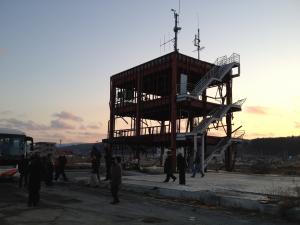
Date: 10-14 December 2012
Place: Nagoya and Sendai (site visit) , Japan
Background Information
As one of the first activities related to the new Disaster Management Planning Programme, UNCRD organized "International Workshop on Disaster Risk Reduction and Resilience Building of Urban Communities" from 10 to 14 December in Aichi, Mie, and Miyagi Prefectures in Japan. The workshop received 10 participants from Africa (Ghana, Kenya, and Mozambique), Asia and Pacific (Bangladesh, Fiji, Nepal, PNG and the Philippines), and Latin America (Argentina and Colombia).
The participants selected for this workshop to come to Japan and share, learn from, and discuss a wide range of experiences and approaches to disaster risk reduction and resilience building were experienced professionals working as senior and mid-level officials for local and national authorities and practitioners from NGOs, CBOs working at national and sub-national (city/village/community) levels in disaster risk and vulnerability reduction of poor communities in their respective countries.
The workshop was conducted by UNCRD staff supported by two consultants from France and the UK who served as resource persons and facilitators.
Summary
The field trip to northeast Japan commenced just after a first half-day field trip to the Mie Prefecture, also part of the study tour planned in the international workshop programme, where participants learned more about, and seen evidence of the different components of the disaster management cycle (disaster prevention, mitigation, preparedness and response and post-disaster reconstruction and recovery) in Japan, a country where a long-standing traditional practice has evolved into a widely recognized cutting-edge disaster risk reduction expertise.
Both field trips complemented the first the part of the workshop, which integrated conventional plenary lectures and presentations on theory, key issues, country cases and good practices related to disaster issues and management practice in human settlements given by UNCRD staff, representatives of Japanese national and sub-national (prefectural) authorities, the international consultants and workshop participants, as well as the plenary discussions that were held during the first two days.
The field trip to the Miyagi Prefecture, northeast Japan, was not only very instructive but also probably the most impressive component of the overall workshop programme and even the most shocking experience for the participants during their whole stay in Japan if not in their whole lifetime. As a matter of fact, the view of the hundreds of bare house foundations, the few stripped and/or flipped-over 2 or 3-storey building structures or empty school buildings (where parents left Christmas gifts under beautifully dressed Christmas trees for their disappeared loved children) standing as so many memorials and monuments in the devastated landscape was a very moving experience.
Those remind the disaster management community of the limitations of such disaster risk management (DRM) systems relying too heavily on structural (so-called hard) measures such as tsunami breakwaters, sea walls, gates, control forests —even when those are amongst the best in the world. This site visit in the affected area led the workshop participants to conclude that many lives could have been spared if people did not put so much trust into those structural elements that were meant to protect them from tsunamis. It also confirmed the principle that even the best protective structural measures need to be balanced with a combination non-structural (or soft) measures such as education, awareness raising, adequate multiple lines of communication systems for tsunami warning, emergency evacuation plans, evacuation drills, (implemented) appropriate building codes and land use planning.
Through the narratives made by local guides and the conversations that followed their presentations the workshop participants could easily feel some general resentment of the survivors against their DRM professionals and national and sub-national authorities as well as their determination to be more involved in the disaster risk management process.
The Government of Japan seemed to have heard the population's grievances and has renewed its efforts to strengthen community participation in the disaster risk reduction strategies at the different national and sub-national levels —efforts that were already perceptible in the presentations made by the representatives of the (Japanese) Ministry of Land, Infrastructure and Transport (MLIT) and the Aichi Prefecture Disaster Prevention, Office of Aichi Prefectural Government on the first day of the workshop held at the Nagoya International Centre.
UNCRD has compiled matters dealt with and lessons learned from the workshop. Please refer to the daft workshop report from the link below.
CONCEPT NOTE
PRESENTATIONS AND SPEECHES

